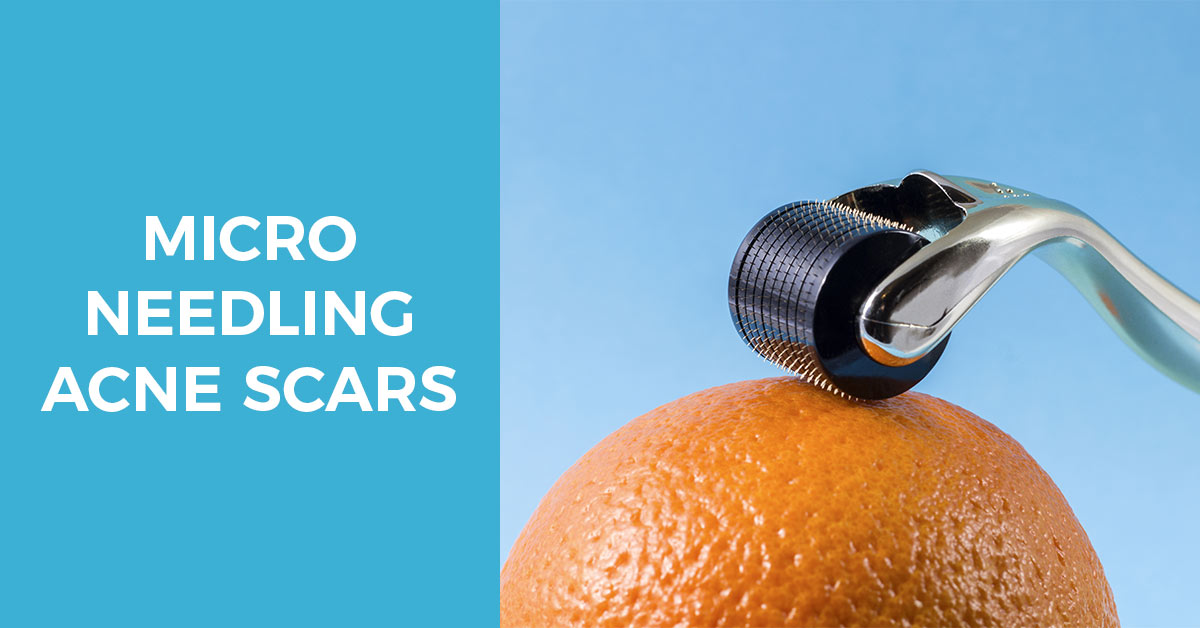Contents
Apart from causing both emotional and physical stress and discomfort while present,inflammatory acne tends to leave scars after they are gone. Thanks a lot, nature.
Ok seriously.
We all know acne scars are a nightmare (maybe even worse than the actual acne), but it doesn’t mean there is no way out. Acne scars can be treated if you know what to do about them. Below we will discuss the numerous types of acne scars and why micro needling acne scars is an effective therapy for restoring your face and giving it the fresh, smooth look it deserves.
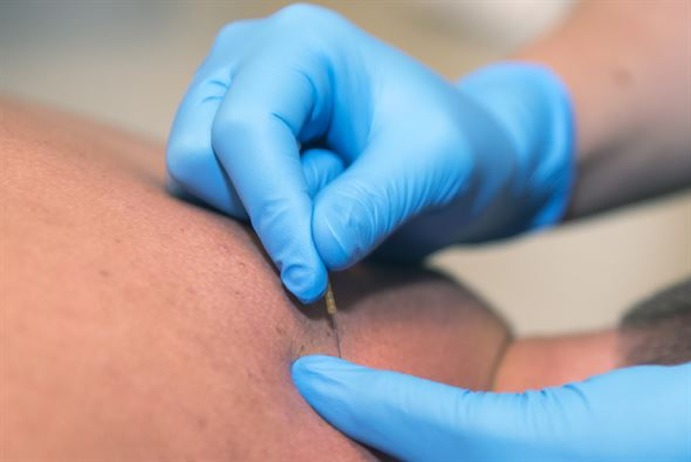
Types of acne scars
Acne scars come in various types, forms and shapes, and because of this, there is no a “one size fits all” approach to curing them. It’s important to know and understand what kind of scars you’re dealing with before proceeding with treatment. Acne scars can be classified into three groups: Depressed scars, Raised scars and Pigmentation.
Depressed scars
Also known as pitted scars (see Boxcar scars), these scars are 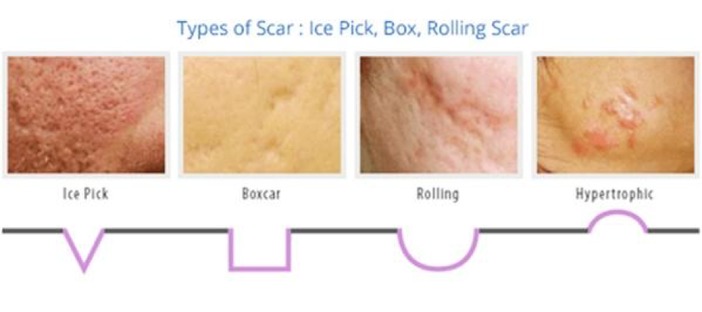 formed by inflammatory acne. Generally, the depression rests on a collagen-rich scar tissue (which makes a large part of the skin itself) and pressures the bottom of the scar into the skin, preventing the growth of a new, healthy tissue.
formed by inflammatory acne. Generally, the depression rests on a collagen-rich scar tissue (which makes a large part of the skin itself) and pressures the bottom of the scar into the skin, preventing the growth of a new, healthy tissue.
There are three main types of depressed scars: Ice pick scars, Rolling scars and Boxcar scars.
Ice pick scars
Appearance: Ice picks are very deep, narrow scars that extend well into the dermis and most commonly resemble a large, empty pore in the skin.
Formation: Ice picks are usually the result of an inflamed cyst or other blemish working its way to the surface of the skin, destroying the skin tissue and leaving a column-like remembrance in the process.
Treatment: Due to ice picks extending deep into the dermis, these scars are the most difficult ones to treat without any surgical procedures. Chemical peels, microdermabrasion and even laser resurfacing, most of the times, aren’t good enough to treat ice picks because they don’t remove enough tissue to get to the very base of the scar. Punch excision or punch grafting surgical therapy and micro needling are the most effective treatment methods when dealing with these types of scars.
Rolling scars
Appearance: Rolling scars are wide, wave-like depressions on the skin that have rounded, sloppy edges. Having a few of these scars in a given area creates a rolling effect on the otherwise normal looking skin.
Formation: Rolling scars are generally the result of having long-term inflammatory acne. These types of scars develop when a fibrous band is formed between the skin and its subcutaneous tissue. The bands “pull down” the skin’s epidermis – the outer layer of the skin – and create the wave-like, rolling effect. Rolling scars tend to become more noticeable with age, when skin starts losing elasticity and fullness.
Treatment: Since rolling scars have sloppy edges, most of the common treatment methods can be effective when dealing with them. Chemical peels, laser resurfacing, microdermabrasion, subcision and especially micro needling can produce highly satisfying results.
Boxcar scars
Appearance: Probably the most common type of depressed scars, boxcars are broad (though they cover much less ground than rolling scars), round or oval depressions with steep, defined vertical edges. Due to being wider than Icepicks, Boxcars give the skin a pitted look.
Formation: Boxcars develop when an inflammatory breakout destroys skin collagen. Without the support, the skin in that area gets depressed and “goes down” forming a tiny crater. These scars vary from being superficial to highly severe, depending on the amount of collagen lost.
Treatment: Since Boxcars have stiffer, defined edges, it is more difficult to smooth them out and blend with the surrounding skin compared to Rolling scars, yet laser therapy, microdermabrasion, skin needling, surgical subcision and chemical peels can be highly effective. Due to those scars’ nature, numerous (around 4-7) procedures might be required to achieve the desired effect.
Raised scars
Also known as hypertrophic and keloid scars, raised scars develop when excess scar tissue is formed at the injured area. They consist of firm, fibrous scar tissue and are slightly raised from the surrounding skin. Hypertrophic scars are less common, can typically be found on the torso and usually have something to do with genetics or secondary infections.
Since keloid scars are raised, they can be effectively treated via laser resurfacing, microdermabrasion and surgical removal. Chemical peels and other mild treatment methods show little to no effect when dealing with hypertrophic scars, due to them being highly resistant to various chemicals compared to the normal skin.
Pigmentation
Inflammatory acne don’t always leave scars when they are gone. Sometimes, you might end up with various kinds of pigmentation or discoloration, which are usually the result of long term acne presence. There are three types of pigmentation scarring: Hyperpigmentation, Hypopigmentation and Erythema.
Hyperpigmentation
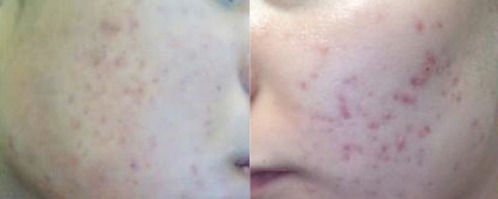
Hyperpigmentation occurs when an excess amount of melanin – the pigment that gives skin its color – is generated at the site of the injury. The results are freckle-like spots and blotches, and this condition can be caused by inflammatory acne. Hyperpigmentation can be effectively treated with laser surgery, micro needling and medications that specifically hinder melanin synthesis.
Hypopigmentation
This condition is the result of excessive loss of melanocytes caused by inflammatory acne, leaving the specific skin area with multiple, pale, circular spots. 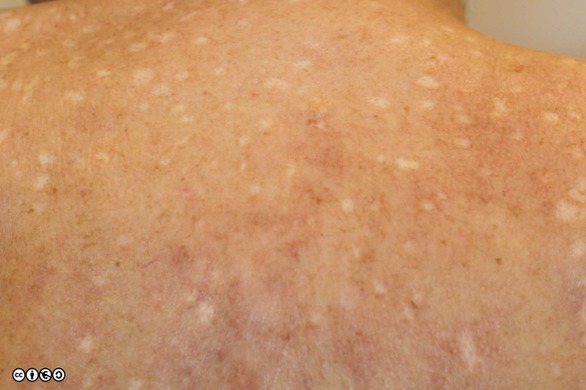 Hypopigmentation is usually more noticeable on darker skin tones and can be treated effectively via various methods including chemical peels, laser surgery, skin needling, etc.
Hypopigmentation is usually more noticeable on darker skin tones and can be treated effectively via various methods including chemical peels, laser surgery, skin needling, etc.
Erythema
Also known as permanent redness, erythema develops when small capillaries – tiny blood vessels – near the surface of the skin become damaged permanently. This gives the area of the skin a constant reddish look and is most noticeable on light skin tones. Erythema can be treated with laser therapy and light based methods that specifically target hemoglobin – the protein in red blood cells.
Micro needling acne scars
In general, depressed scars make the vast majority of acne scars among all people around the world and micro needling is a highly effective and inexpensive therapy to get rid of them. It works by creating tiny punctures in the skin with the help of various needles (also known as pens) to enhance natural skin rejuvenation and collagen production, eventually soothing and smoothing out the skin.
Depending on the severity of the case, a number of procedures (usually 4-6) will be required to vanquish all acne scars. Make dead sure to get a consultation with a certified surgeon or dermatologist to understand which type of needling you want to go for, how many sessions it will require to improve the appearance of scars, which type of micro needling products they will use and how will the whole procedure go on in general.
Avoid using the services of uncertified clinics since micro needling acne scars can carry side effects (although very mild). You might also be allergic to some products that are used during and after the procedure like anesthetics, which can lead to some nasty consequences. Finally, the usage of nonsterile products can lead to skin infections, making your life even harder than it was.
Types of Micro needling
Micro needling has been around for a long time, but it has recently gained a lot of attraction from people due to its affordable cost and effectiveness. The needles can be broken down into three types: rolling needles, pen needles (pens) and radiofrequency (RF) tipped needles.
Rolling Needles
The procedure was popularized by Dr. Fernandez in Cape Town, South Africa. This treatment involves the oldest type of needles – rolling needles – and is heavily dependent on precision, accuracy and experience to produce satisfactory results. Rolling needles are effective when dealing with mild acne scars after a few sessions, but won’t do much good when fighting more severe acne scarring cases. The procedure itself can be quite bloody, but the result is worth it.
Pen Needles
Micro needling pens work by inserting a number of motorized needles into the skin. Products like MicroPen and DermaPen are popular choices when going for this needling type and can produce effective results after a few procedures. Pen needles are generally used to treat the same cases as rolling needles, with the difference of going through much less bloody procedures and dealing with less pain during the whole process. Again, experience and precision are key so make sure to seek qualified professionals’ help.
RF tipped Needles
The latest generation of micro needles use radiofrequency waves to penetrate the skin on various depths and induce regenerative and natural healing effects of the skin. The procedure involves almost no blood since the RF current also coagulates blood vessels while penetrating the skin, which helps minimize bleeding. The current is color-blind, meaning that it can be used for all skin types.
This therapy can also be highly effective for reducing the chances of future acne development since it shrinks pore size, while fixing tone and texture at the same time. Due to its highly invasive ability, RF tipped needles can be used to treat even the most severe cases of acne scarring over the course of 1-4 procedures.
Customer reviews: micro needling before and after
Here is one such post with images you should have a look at. Micro needling does help deal with even some of the most severe, cystic acne scarring cases. Here is a story of a young man you need to see, and his results after micro needling.
Also, make sure to check out this video by Kristina Wilde showing her case of hyperpigmentation and the results after micro needling.
Here is another video by a young woman telling her story about acne scars and showing the great results of micro needling procedures.
Conclusion – Never get discouraged!
Acne scars are a huge nuisance and discomfort that you have to deal with every day. I don’t need anybody to tell me that – I know from personal experience.
But!
If you start taking the matter too close to heart, you risk getting constantly stressed and depressed, and losing the willingness to fight back. Never allow acne (or acne scars) get the better of you! The right treatment is out there and it is available, all you need to do is find what works best for your specific case, and go with it until your skin is perfect – as it is supposed to be.

